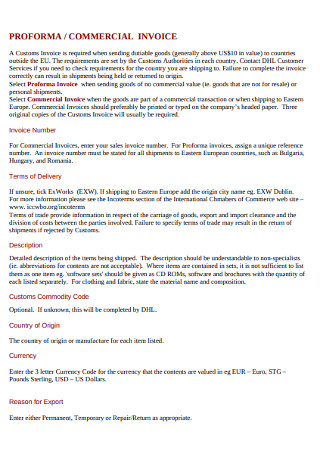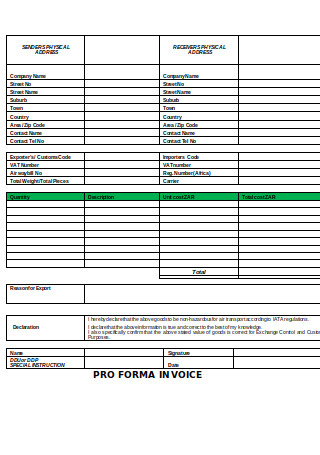17+ Sample Proforma Invoices
-

Proforma Invoice Form
download now -

Proforma Invoice and Goods
download now -

Quotation Proforma Invoice
download now -

Proforma and Commercial Invoice
download now -

Deringer Proforma Invoice
download now -

Request for Pro-forma Invoice
download now -

Specimen Proforma Invoice
download now -

Return Proforma Invoice
download now -

Simple Proforma Invoice
download now -

Information Sheet for Pro Forma Invoices
download now -

Formal Proforma Invoice
download now -

Proforma Invoice for Returns
download now -

Proforma Invoice Request Form
download now -

Quation Cum Proforma Invocie
download now -

Proforma Tax Invoice Template
download now -

Proforma Invocie for Agent Commission
download now -

Customs Proforma Invoice
download now -

Sample Proforma Invoice
download now
FREE Proforma Invoice s to Download
17+ Sample Proforma Invoices
What Is a Proforma Invoice?
Elements of a Proforma Invoice
How to Write a Proforma Invoice
FAQs
What is the purpose of a proforma invoice?
What are the benefits of having a proforma invoice?
Is there a difference between a proforma invoice from a commercial invoice?
Are payments possible only by having a proforma invoice?
For this, the company holds a pro forma invoice that assures a particular amount of materials for transport and delivery, upholding the prior purchase made by the organization. A proforma invoice helps to ensure supplies come in on their designated dates, especially materials arriving from overseas shipping. Proforma invoices are essential in productions and operations, and individuals must know what they are. Learn about proforma invoices in the article below with supporting information about their description, composition, and elements, with additional details through frequently asked questions.
What Is a Proforma Invoice?
Proforma is the Latin word translating to ‘as a matter of form’ or ‘for the sake of form’. A proforma invoice is a preliminary bill of sale for a shipment or delivery of goods or items in advance, sent to a buyer. Proforma invoices present a specific sales price to the customer. The content of the invoice requires only necessary information to allow the package to pass a general examination by the customs officers for the goods. Businesses and organizations utilize these forms to satisfy their internal purchase approval process, making it a necessary document for importing and exporting goods. The proforma invoice serves as a vital piece of documentation going with various kinds of purchase orders for international shipping from one country to another.
According to the data by the World Integrated Trade Solutions (WITS) developed by the World Bank, the overall imports and exports for the United States in 2018 amounted to approximately 4.2 billion US dollars, with exports amounting to 1.66 billion US dollars and imports amounting to 2.61 billion US dollars. Business is still active throughout the globe during 2018. However, as many businesses suffered during the pandemic, the import and export of goods and services declined.
Elements of a Proforma Invoice
Organizations ship out the agreed-upon deliverables with the proforma invoice or before sending the goods. The proforma invoice contains the exact cost details connected with the sale. However, it is not an official document of payment. There are no specific guidelines that dictate the actual representation or format requirements for a proforma invoice. However, certain elements must reflect on it for the customs’ general inspection. Here is a list of information that must be present in the proforma invoice.
How to Write a Proforma Invoice
A proforma invoice looks similar to a regular invoice document or a bill of sale. As stated above, it contains the description of the product, a listing of charges, and sales terms. The difference lies in the document stating that it is a proforma invoice. Here are helpful steps in creating a pro forma invoice for a transaction.
Step 1: Mark the Invoice Clearly
State that the document is a proforma invoice. The consumer must know that the invoice they received is only proforma to avoid confusion and misunderstandings. It must also indicate a unique identification number necessary in record-keeping and reference documentation. Note that the identification is different from an invoice number.
Step 2: Include Buyer and Seller Information
The document must show the accurate details of the seller, including the company or the individual’s name, address, and contact information. The customer’s name or company name and address, including a representative contact, ensures the invoice reaches the correct person. The details are necessary to guarantee that the parties are involved in a transaction. If there are conflicts or complications regarding the items, for example, missing or damaged goods, the buyer can quickly contact the merchant for clarification or return.
Step 3: Write an Accurate Description of the Goods and Their Prices
The description of each item does not need to be unbelievably lengthy. However, it must hold the relevant details enough for the customers to identify the item for payment. Some consumers receive various invoices daily, and some do not notice the objects included in the package. Instead of these buyers inquiring about the items, it is helpful for the merchant to state them clearly. Once an accurate description is available, include the number of items and the corresponding prices based on a price list.
Step 4: Indicate Relevant Dates in the Invoice
The proforma invoice must show the issuance date or the date when the buyer purchased the goods. It must also indicate the date the merchant provided or packed the goods for shipping. It must also show an estimated date of delivery for the buyer to know when the package arrives. The supply date is supplied right after the description of the goods, and the issuance date and delivery date at the upper right-hand portion of the proforma invoice.
Step 5: Calculate the Total Price of Items
After completing to pack the items in a package, the merchant computes the cost of individual goods with its number to total the amount owed by the buyer. If the buyer avails of a discount offered by the buyer, include it in the proforma invoice and subtract it from the total cost. Other applicable insurances, taxes, and duties must also reflect in the computation of the charges.
Step 6: Include the Terms of Sale and Payment
It is always relevant to include all relevant terms and conditions in the sale of a product. If there is a formal agreement between buyer and seller with the payment dates and provisions, indicate them in the proforma invoice. It is also necessary to note how the client intends to pay for the product. If the payment method is through a bank account, specify the details for the customer to deposit the sum into the corresponding bank. Accurate and precise payment terms help in ensuring a stable cash flow and lessen any problems. The term of sale is also necessary and must include cancellation and return clauses for the benefit of the consumer and merchant.
FAQs
What is the purpose of a proforma invoice?
The principal purpose of a pro forma invoice is to simplify the sales process. Once the merchant sends the proforma invoice, the customer then agrees to the exact price and then sending the goods follows. Proforma invoices are reliable estimates by the seller allowing the customer to have a picture of expectation. It is also frequently used for declaring the value of goods for customs to have a smooth transaction. A proforma is also beneficial when there are no sufficient details available for a commercial invoice. Aside from that, some clients utilize it for internal purchase approval processes.
What are the benefits of having a proforma invoice?
While many people believe it is unnecessary, there are benefits to creating this type of document. For one, proforma invoices provide relevant information for delivery. As indicated in the components of a proforma invoice, details like the breakdown of items and their costs are visible. Due dates and invoice numbers are not necessary until the final creation of the invoice. It also provides a certain level of commitment between the parties. A proforma invoice can also serve as a price quotation or a purchase order for the customer to get the approval of the sale to receive the commercial invoice. Finally, the invoice serves as a negotiation tool for the seller and buyer. The invoice contains relevant information, including the terms of sale and payment. It provides the parties room for renegotiation and makes necessary arrangements. While it is more beneficial to customers, it is also advantageous to the merchant in expanding their client list through customer loyalty.
Is there a difference between a proforma invoice from a commercial invoice?
There are plenty of similarities between a proforma invoice and a traditional commercial invoice. Both provide details such as the description of goods, shipping details, quantity, unit cost, and total costs. The most notable difference between the two is their legal status. A proforma invoice is sent to a client as a form of courtesy without it being a binding agreement between the seller and buyer. On the other hand, a commercial invoice does. A proforma invoice is a non-binding document meant to inform a client of the product, while a standard invoice is binding and commits the client to pay for the goods. Whereas the merchant offers the proforma invoice before turning over the goods, the standard invoice is sent after the delivery and received by the customer. While proforma invoices are open to negotiations, an invoice is not. Lastly, a proforma is valid for a limited amount of time. Meanwhile, a standard invoice is only valid up until the terms have been satisfied.
Are payments possible only by having a proforma invoice?
By using a proforma invoice, the department handling payments has the option to issue amounts on behalf of the client in advance against an actual invoice. The invoice in itself avoids any misunderstandings about the actual price of goods. Once the order is complete, there must be a reference to the proforma invoice number that can be transferred to a standard invoice to avoid payment duplications by the individual or organization. It is noteworthy that the client holds on to the proforma document, along with the standard invoice for record-keeping and reference. However, once a customer receives a proforma invoice from an overseas client, they are not obligated in any way to pay for the shipped items. As stated above, a proforma invoice is not a standard invoice.
When money is involved in transactions, it is necessary to receive a document that provides all relevant information relating to the product or service. In most cases, organizations always seek invoices and other related documents as proofs or deeds of sales. While proforma invoices are irrelevant or unnecessary to particular businesses, it holds significance, especially in international transactions, consignments, or business matters requiring more formal documentation before finalizing a sale.
In which case, the merchant must know a proforma invoice. There is always room for discovering new ideas and information, especially if it helps gain clients and boost brand recognition. In the words of Nicolaus Copernicus, “To know that we know what we know, and to know that we do not know what we do not know, that is true knowledge.” It’s best to realize shortcomings and work towards understanding them. Start with proforma invoices samples that are available for use and download in the article above.
